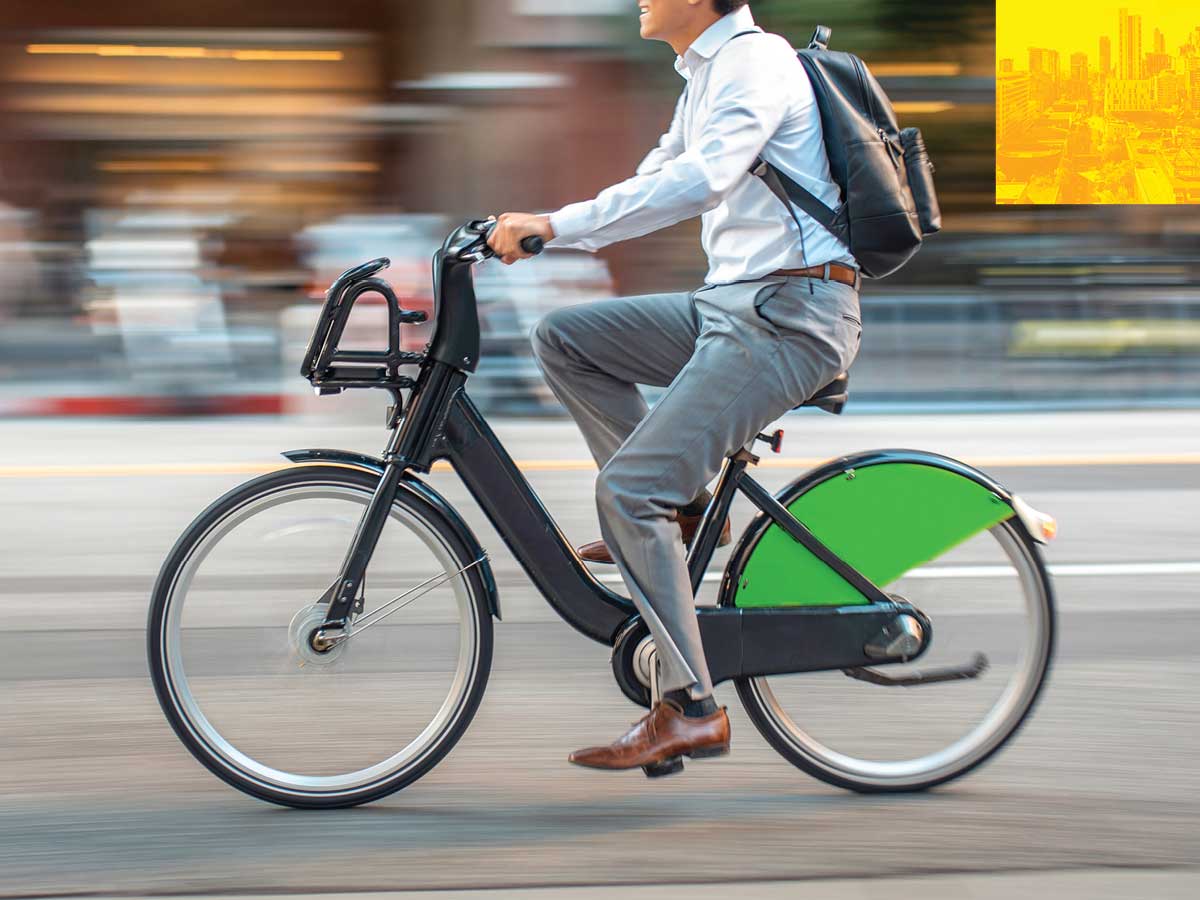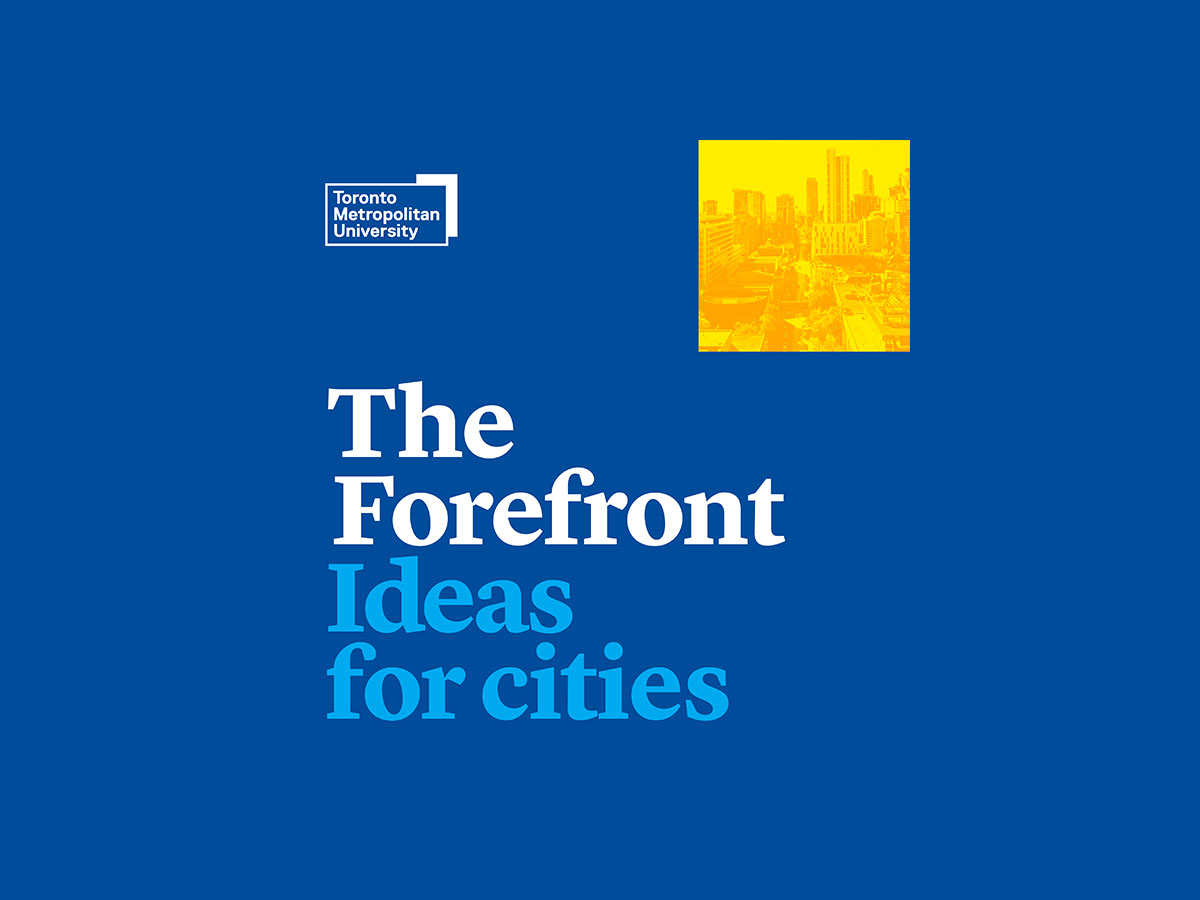Bike lanes and big cities

Season 3, Episode 5
Description
Canadians continue to be divided on bike lanes on city streets. However, research (opens in new window) out of TMU shows that after developing protected bike lanes, four in ten users in Toronto were new cyclists. Before this infrastructure existed, these cyclists would have used an alternate means of travel. This is good news for municipalities looking to reduce congestion on city streets.
In this episode, we chat with TMU expert Raktim Mitra about the benefits of building safe cycling infrastructure and some of the issues preventing people from taking up cycling.
THEME MUSIC UP
Amanda: [00:00- 00:09] This is The Forefront, a podcast that explores ideas for cities. I’m Amanda Cupido.
THEME MUSIC RESOLVES
[00:14-00:44] So here’s the problem: Canadians continue to be polarized on the topic of bike lanes. It tends to lead to heated municipal debates – mostly because Canadians love their cars. According to Statistics Canada, 4 out of 5 Canadian commuters get to work in a private vehicle. But cars are expensive and can take up a lot of space on roads. Plus, the greenhouse gasses they give off are a major contributor to climate change.
So you'd think biking would the perfect solution, right?
Ian Cantello: [0:45-1:20] I actually don't bike that much when I was a kid, I biked as much as anybody else did. And then I've actually been mostly a pedestrian, for, for most of my life.
[0:54-1:05] This is Ian Cantello. He’s a transportation master plan coordinator for the City of Regina. He's also an urban planning graduate from Toronto Metropolitan University.
Ian: [1:06-1:25] the fact that I don't bike much myself is actually illustrative of a lot of the folks that do put bike infrastructure in North American cities. In the prairies in particular, you'd see the majority of this of this infrastructure being built by folks that drive and may have only really ever driven to a job over the course of their careers.
This might sound strange to you—cycling enthusiasts that don’t cycle. But if you think about it, it makes sense. Ian and his colleagues are working on bringing cycling infrastructure to Regina…because much of that infrastructure, like dedicated bike lanes, doesn’t exist yet.
Ian: [1:43-1:49] Cyclists are always the most vulnerable road user, right, they lose every interaction they have with a car.
And while some of you might be brave enough to cycle the city streets alongside cars, that’s a big ask for most Canadians. According to Ian, there are four types of people…
Ian: [1:59-2:35]One category, that's the folks that like, just today, right now are on the street, they're like strong and confident, they're really comfortable biking in mixed traffic, then there's another group that sort of the, very interested, but but you know, cautious, and I definitely fit into that group where I feel that like, you know, I'm not, I'm not a good enough a biker to, to be in mixed traffic. But if there is a bunch of sort of like bike lanes and dedicated infrastructure on the street, that would support my biking, then absolutely, I would, I would be someone who biked to work every day
I fit into this last category, too. I actually did start biking in Toronto the moment dedicated bike lanes were added on the street in front of my home. Soon, I ventured onto regular roads and not long after, I was hit by a car coming up on my left side. Andddd that was the last time I tried biking. Luckily my injuries were minor, but it's these kinds of stories that can scare people out of trying.
Anyway, Ian explains the next category includes…
Ian: [3:00-3:24] people that are like, a lot more cautious and would require sort of very, you know, they would bike but they, you know, don't want to ever be on a street. And you know, would only be using sort of what are typically called multiuse pathways, which is a type of off street infrastructure, what you'd see in like a park or something like that. And then there's the final category of people that that is just like, absolutely no way, I'm never gonna, I'm never gonna bike under any circumstances.
Ian says that the first group, the confident cyclists, is pretty small: 3-5% of people. The last three groups are each about 30% of people. That means that 60% of Canadians convinced to cycle more.
Raktim: [3:41-3:57] Well look, bicycling is one of the easiest ways to promote sustainable transportation. It costs nothing to bike. And it is good for the environment, good for people's health and well being.
This is Dr. Raktim Mitra [ROCK-teem MEET-rah], an Associate Professor at TMU's School of Urban and Regional Planning
[4:05-4:31] when we put these benefits in the context, when about a third of all daily trips that we make in this region,are actually short trips that are less than five kilometres in length. Bicycling, theoretically, at least, it can be a very attractive option, as an alternative to driving and other less sustainable transportation options.
Back in 2015, Dr. Mitra started a massive research study. He wanted to answer a simple question: does new cycling infrastructure actually lead to more cycling? The short answer is yes.
[TRANSITION MUSIC]
[4:53-5:11] Dr. Mitra and his team looked at eleven locations in southern Ontario, including Bloor St in Toronto. All of the locations had new bike facilities built between 2015 and 2018. They surveyed people who lived in these areas and compared them to people in similar areas without bike paths.
Raktim: [5:12- 5:41] what we are seeing is that in neighbourhoods that have these new bicycle lanes, or cycle tracks, people are bicycling more frequently. In other words, people who were only occasionally bicycling for commute purposes, have become more regular cyclists in areas where they have access to these newly built bicycle lanes and cycle tracks, certainly, this is a positive sign.
Specifically, their results showed that there are more than 2 times higher odds of increased biking on streets with new bike lanes.
Raktim: [5:50-6:13] I think that we have seen a significant growth in bicycling uptake over the past decade, even when the inverse investment in bicycling infrastructure has often fallen behind. So the public interest is there more and more people are interested in bicycling, many are not taking up bicycling because they don't fit feel safe.
So he began looking at PROTECTED bike lanes. These are lanes with delineators or concrete barriers or even planters. I will admit – what got me on the bike to begin with was not only a dedicated bike lane, but a protected bike lane. And I'm not alone. Dr. Mitra's research showed where there were those protected bike lanes, four in ten users were new cyclists.
Raktim: [6:37- 7:06] If we provide safer infrastructure Then more or more people, more than more people would take on bicycling. And this is something that we are seeing across the country, by cycles are probably the fastest growing commute mode in the country if we look at the statistical data. So the momentum is there. It has to be supported by good policy and good infrastructure.
The problem with that is, they can be expensive, anywhere from $20,000 to $350,000 per kilometre. But Dr. Raktim says cities don't necessarily NEED protected lanes everywhere.
Raktim: [7:20-8:17] how it should look should depend on the characteristics of the street or road on which a cycling facility is built. On a street where speed limits are low, up to 30 kilometres an hour or even lower. Cyclists can relatively safely share spaces with motorized vehicles. But when the speed limit for a street is higher than that, which is the case for most streets, in our region, a safe cycling facility is the one that is physically separated from motorized traffic, just like how pedestrians have a separate space on the sidewalks, by cyclists should also have separate space for them to them to safely safely travel.
But for those areas that really do require a protected bike lane for new cyclists to feel safe — dealing with the snow we get in Canada is a whole other can of worms...
Ian: [8:29:22-8:49] when you when you're cleaning out the bike lane, where do you put the snow? When you're cleaning up the road next to the bike lane, where does the snow go? it's a new thing for maintenance. You know, previously, if you have a painted bike lane, it's very easy to just push the snow across it and, you know, dust your hands off, and you're good. That is, is something that that we're we're working with and dealing with now.
Even if you can figure out where to put the snow, there’s still the question of how to pick up the snow.
Ian: [8:55-9:12] a typical bike lane or a single lane for a bike is going to be at the very minimum about 1.8 meters wide. that is really narrow for almost any kind of street plow unless you buy a custom machine of some kind or another.
And on top of all of those logistical problems, there’s still the question of how you get people out of their warm cars and onto a bicycle when it’s -15 degrees outside or maybe even -20 outside.
Ian’s answer to this is pretty straightforward: some places in the world are already doing it. Specifically, Oulu, Finland.
Ian: [9:32-10:06] Oulu has something like 22% of their population year round uses a bike. Their city is about the same size as Regina, both in population and geography. And the you know, the temperature is a little bit warmer than it is generally in Regina, but they get like twice as much snow. So you know, it's not it's not a, like their winters are maybe a little bit easier, maybe not depending upon how much you like shoveling or how much you like bitter cold.
Ian figures that if the people of Oulu [OO-loo] can learn to brave the cold on bikes, so can the people of Regina. Right now, about 1% of Regina residents might bike in the winter. Ian thinks it's realistic for that number to go up.
Ian: [10:20-10:34] Even if we're at four or five that's still you know, you can hit 5% You know cycling you In the winter? 1 in 20 cars off the road isn't too bad. That's, that's a significant improvement. From my perspective.
As for snow removal, Ian tells me that the city of Oulu [OO-loo] has invested heavily in snow clearing equipment. Back in Canada, Montreal is known for being the most progressive with its bike lane development. But Dr. Mitra knows that Canada has a long way to go in changing its car-centric culture.
Raktim: [10:50-11:16] it goes to our broader culture around mobility in general, where automobiles are seen and perceived, as, you know, something that represents independence, something that represents comfort, something that represents convenience. And as a result, the alternatives often are not as welcome as you would think they should be.
While he waits for the rest of Canada to catch up with his research findings, Dr. Mitra has turned his attention to other types of cycling-related challenges.
Raktim: [11:23-13:01] the majority of cyclists in North America are men. In in Canada, for example, about 70% of those who cycle are men and working edge adult men. And there's a there's a significant under representation of women, older people and younger people in our bicyclists population. So the question then is, what is it that is keeping these people away from bicycling? We've done some work focusing on a woman in particular, and we saw that compared to men, woman are significantly more concerned about them being bullied when bicycling. So the question then becomes, what are the ways in which we can address some of these concerns? Of course, a fundamental shift in the culture of mobility and the space of woman on our streets need to be addressed. But in the shorter term, what we are trying to argue is that safer infrastructure, safer bicycle lanes, cycle tracks, can contribute to creating these safer environments, on streets for woman and other vulnerable population groups.
Wrapping up, here’s a final word from Dr. Mitra on how TMU has supported his research.
THEME MUSIC UP
Raktim: [13:10-14:21] Well, Toronto metropolitan university, because of where we are, we are at the center of all these actions, we have seen significant investment in by cycling infrastructure around our campus, which is why I became interested in this topic in the first place. I mean, as as someone who works there, I commute, using by cycle to the university and I am concerned about the safety of my bicycle routes, particularly in and around our university campus, which is why I was initially interested in this work. And, you know, Tmu, being a university that emphasizes and takes pride in undertaking policy relevant research. I, it certainly played a role in me exploring more the role of policymaking and planning practices in addressing this issue.
Amanda: [14:22-15:01] This podcast was created for alumni and friends by University Advancement at Toronto Metropolitan University in partnership with City Building at Toronto Metropolitan University. Special thanks to our guests on today’s episode: Raktim Mitra and Ian Cantello. This podcast was produced by me, Amanda Cupido and Emily Morantz. Katia Galati was the editor for the show. All of us are proud grads of TMU! To learn more about Dr. Mitra’s research, and for more episodes of this podcast and others, visit torontomu.ca/alumni/podcasts.
THEME MUSIC RESOLVES

The Forefront is a proud recipient of the Canadian Online Publishing Awards for Best Podcast in 2023 (silver).

The Forefront is a proud recipient of the Canadian Council for the Advancement of Education (CCAE) Prix d’Excellence Award.
